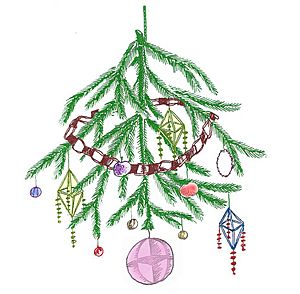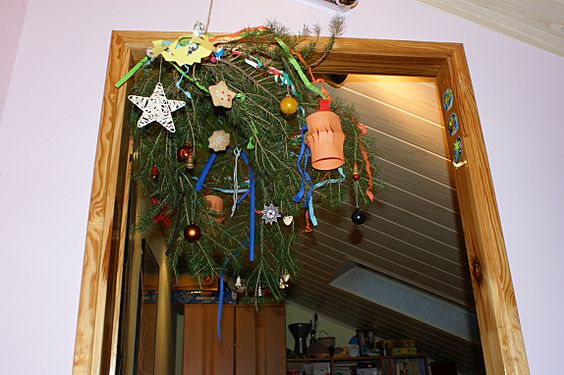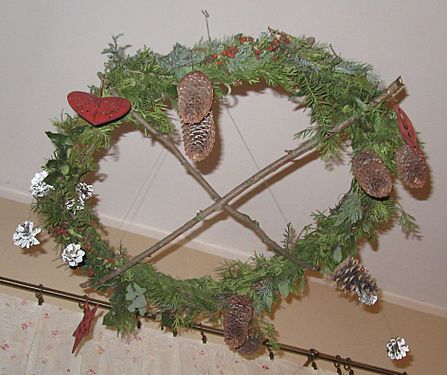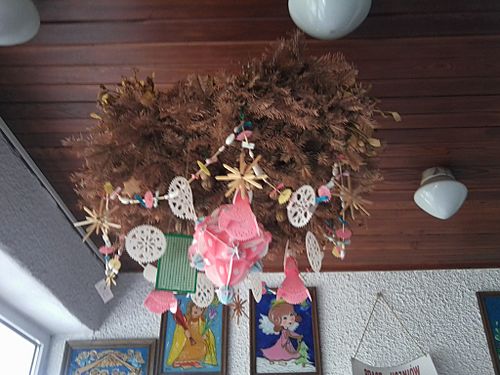Podłaźniczka facts for kids
Podłaźniczka, also known as polazňička, is a special Christmas decoration from Poland and Slovakia. People usually made it from the top of a conifer tree, like a fir or spruce, turned upside down. They would then decorate it with colorful tissue paper, candies, apples, nuts, or special Polish shapes made from christmas wafer. Sometimes, it was even made from straw.
This unique decoration was hung above the Christmas Eve dinner table or in a corner of the house. People believed it would bring good luck and wealth to the family living there. The idea of the Podłaźniczka comes from an old tradition involving a person called a połaźnik.
In Serbia, a similar branch was known as šumka od položenjca or polaznikova šumka.
Contents
What is Podłaźniczka?
The custom of the podłaźniczka is closely linked to the tradition of the połaźnik. A polaznik was the very first guest to visit a house on Christmas Day. People believed that if a healthy, young, and happy person arrived first, they would bring good fortune to the home for the whole year.
Often, the polaznik would bring green twigs with them. In Poland, these twigs were called podłaźniczki. A similar custom of bringing evergreen plants by the polaznik also existed in Slovakia and Bulgaria. In some regions, like among the Lemkos, a special bundle of straw called a didok was brought home.
Podłaźniczka in Poland

In Poland, the podłaźniczka had many different names. Some people called it połaźniczka, połaźnik, podłaźnik, podłaźnica, jutka, sad, sad rajski, boże drzewko, rajskie drzewko, wiecha, or gaik.
The podłaźniczka was most popular in the Goral Lands of Poland. It could be made in different ways. Sometimes it was a whole conifer tree, or just the top part of a conifer tree turned upside down. It could also be a single branch from a conifer. Another way was to attach green twigs to a ring from a riddle (a tool for sifting).
Once ready, this decoration was hung from a ceiling beam, often right above the Christmas table. It could also be placed in a special sacred corner of the house. Many people see the podłaźniczka as an early version of the modern Christmas tree in Poland.
People believed the podłaźniczka would bring good luck and wealth to the family. It was also thought to protect farm animals from wolves and diseases.
How it was Made and Decorated
Podłaźniczka decorations were usually handmade. They were often crafted from tissue paper or colored paper. A very special decoration was called światy (meaning "worlds"). These were pieces of christmas wafer joined together. People would shape the wafer into different forms like crosses, suns, or crescent moons. Sometimes, they even colored them.
These światy were made on Christmas Eve, which gave the ornament another name: wilijki. Sometimes, the światy became a decoration on their own, hung directly from the ceiling beam. Besides paper and wafer decorations, the podłaźniczka was also adorned with candies, apples, cookies, nuts, or shiny flax seeds. After World War II, people started using modern baubles too. Before the modern Christmas tree became popular, a straw decoration called a pająk (meaning "spider") was a similar type of hanging ornament.
Podłaźniczka in Slovakia
In Slovakia, a similar ornament was known as polazňička. This could be a straw hen, for example, in the upper Spiš region. It was hung over the Christmas table. This straw hen had a similar meaning to the green conifer ornament or Christmas tree. Sometimes, a branch from a coniferous tree brought by a polaznik was also called polazňička.
The name polazňička was also given to a special Christmas bread in Slovakia. In the area where Slovakia borders Moravia, polazňička was sometimes called "happiness." This connects to the Polish belief that the podłaźniczka brings good luck.
Images for kids
See also




